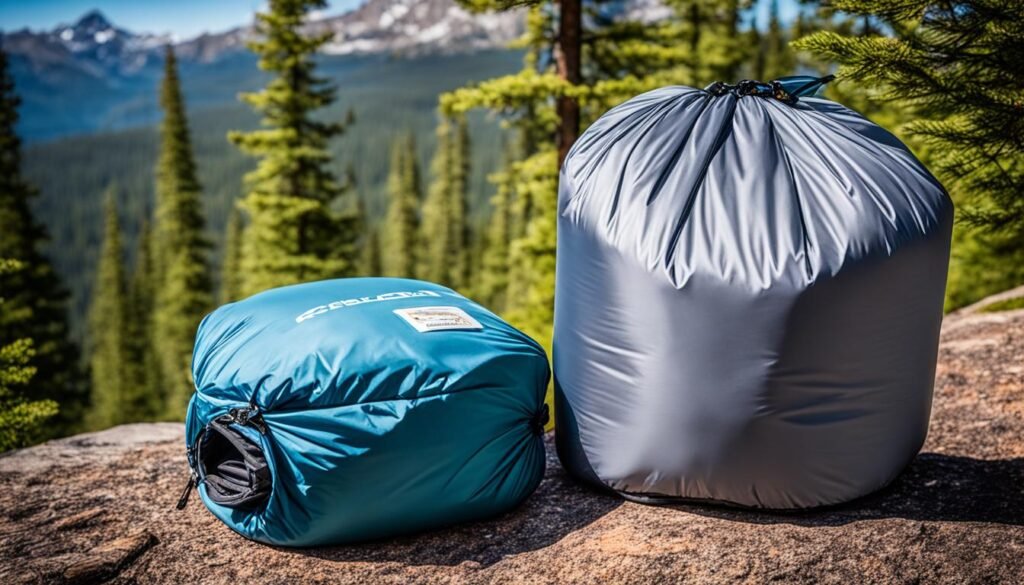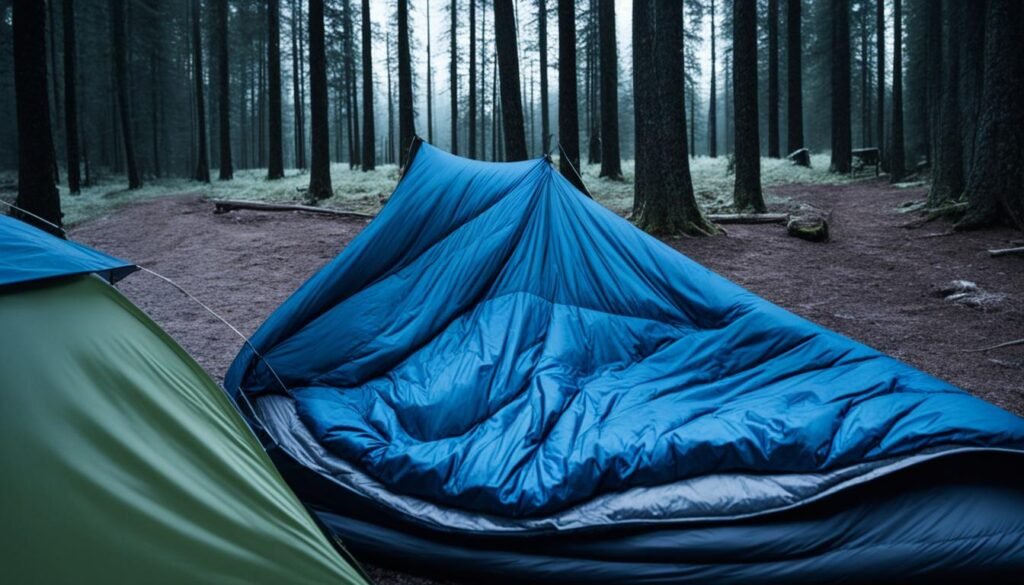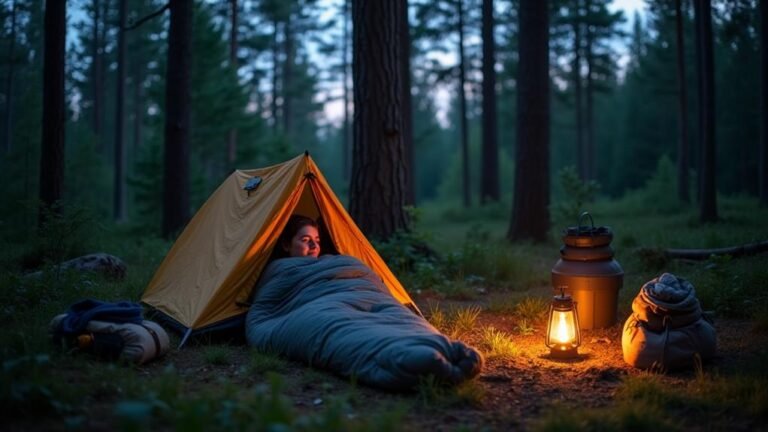Do you know a sleeping bag liner can make your bag feel up to 16.2°F warmer?1 This surprising fact shows how important a liner can be for outdoor sleeping. We, as people who love camping and hiking, know how crucial it is to improve your sleep gear for better warmth, air flow, and cleanliness. This guide focuses on the best liners to help you sleep better under the stars.
For any adventure, getting the right sleeping bag liner can really change your experience. This article will look at important factors, like different materials, and the best liners out there. We’re here to guide you, whether you need something light and easy to carry or thick and warm.2
Key Takeaways
- Sleeping bag liners come in a variety of materials, including silk, fleece, and cotton, each with unique performance characteristics.
- Liners can add up to 16.2°F of warmth to a sleeping bag, making them essential for cold-weather camping.1
- Ultralight and compact liner options are perfect for backpackers looking to minimize weight and pack size.
- Proper care and maintenance can extend the life and performance of your sleeping bag liner.
- Versatile liners can be used in different seasons, from warm weather to cold, for optimal comfort and temperature regulation.
Why Use a Sleeping Bag Liner
Sleeping bag liners have many benefits for your adventures.3 They keep your sleeping bag clean and easy to care for. They also make you warmer, manage temperature, and are light to carry.
Keeps Your Sleeping Bag Clean
Using a liner stops oils and dirt from going into your sleeping bag. This keeps your bag fresh and reduces how often you need to wash it.4
Easy to Clean
Liners are simple to wash, often in a machine with regular detergent. This keeps your sleeping area clean and healthy with little effort.4
Adds Warmth
They can make your sleep gear up to 15 degrees warmer. This is great for chilly nights outdoors.3 Some liners are designed to reflect heat back to you, adding extra coziness.
Regulates Temperature
Many liners use materials that breathe and pull moisture away. This helps you stay at a comfortable temperature, avoiding being too warm or cold.3 Options like Silk Blend, Comfort Blend, and Breeze manage moisture and air well.
Lightweight Layer
Linens are easy to carry. They can work by themselves in the heat or add warmth when it’s cold.4 For example, the Silk Blend Liner is light, weighing just 4.6 oz / 130g for the Compact Mummy version.
Adding a quality sleeping bag liner to your gear improves your sleep outdoors.34
Warmth and Breathability Considerations
Choosing a sleeping bag liner requires finding a good balance. It should keep you warm but not make you sweat. The top liners add warmth, around 15 degrees, without getting too hot.1 They use materials like fleece or synthetic fabrics to keep your body heat close. They also need to be good at letting moisture out, keeping you dry and comfortable all night. The perfect liner does both, keeping you snug and adjusting to your temperature needs.
Warmth Provided by Liners
How much a sleeping bag liner warms you up depends on what it’s made of. For instance, a microfleece liner can add 14.3°F to the warmth,1 while an organic cotton liner adds about 5.3°F.1 The right silk liner can give you up to 9.5°F more heat.1 If you want something even warmer, consider Thermolite® Radiator liners, which add 16.2°F,1 or the Thermolite® Performer that boosts it by 12.6°F.1
Moisture Wicking and Breathability
Good liners should also let moisture out while keeping you warm. Polyester liners are thin and pack small, but they don’t breathe well.5 This can make you feel sticky. Cotton liners, though, are great for letting your skin breathe. They feel like your regular bedsheets and work well in warm weather.5 For something that’s warm and still lets air through, check silk liners. They’re light and easy to pack. They keep you cozy in the cold and comfortable when it’s hot.5
Looking at how liners add warmth and handle moisture helps you pick the best option. It ensures you sleep well in any weather.
Best Sleeping Bag Liners
Finding the best sleeping bag liners is key for any camper. We’ve sorted through many to bring you informed recommendations. Each liner is detailed for its best use in camping and backpacking.
Silk Blend Liners from SleeptoSummit are a top pick. The Compact Mummy version is just 4.6 oz. This makes it perfect for those up to 5’10” / 178cm. They’re super light and dry fast, perfect for anyone hiking.4
Need a liner that adds warmth? The Reactor liners from SleeptoSummit are great. The Compact Mummy Reactor adds up to 14 degrees and only weighs 9.5 oz. It’s an excellent choice for cooler nights.46
The Comfort Blend Liner is both comfortable and stretchy. It doesn’t have side seams, making it ideal for moisture control. If you’re looking to save, consider the Breeze liner. It’s made with Coolmax and is known for being stretchy and good at keeping you dry.4
We’ve put together a comparison table of the best sleeping bag liners. It shows the top features and what each liner is best at. This makes picking the right one easier. Take a look at it:
| Liner | Material | Weight | Packed Size | Price | Warmth Added |
|---|---|---|---|---|---|
| Western Mountaineering Tioga | 100% Silk | 3.6 oz (0.225 lbs) | 2.25 x 4 in | $80+ | 5-25 degrees |
| Cocoon Coolmax | CoolMax Polyester | 9.0 oz (0.56 lbs) | 3.5 x 7 in | $65 | 5-25 degrees |
| Alps Mountaineering Microfiber Mummy | Polyester | 11 oz (0.69 lbs) | 7.5 x 3 in | $25 | 5-25 degrees |
| Sea to Summit Reactor Thermolite | Thermolite Polyester | 8.7 oz (0.54 lbs) | 5.8 x 4 in | $80+ | Up to 14 degrees |
The right sleeping bag liner depends on your needs. Options range from silk, ideal for its weight, to synthetic for extra warmth. We help you find your best fit.467
Whether you want more warmth, less weight, or extra comfort, our guide is here to help. We’ll find the perfect sleeping bag liner for your camping adventures.467
Comparison of Popular Liner Materials
Choosing the right sleeping bag liner is key for your outdoor trips. It’s essential to know what silk, cotton, and synthetic liners offer. Each type has its pros and cons. So, let’s look at what matters when picking one.
Silk Liners
Silk liners are great for being light and small.6 The Western Mountaineering Tioga silk liner, for instance, weighs just 3.6 oz. It folds down to a tiny 2.25 x 4 inches.6 Silk also breathes well and keeps you comfortable in warm weather.1 Our Silk Blend Liners are super light and dry fast, thanks to their Comfort Stretch panels.4
Cotton Liners
Cotton liners give a cozy, natural feel and pull moisture away.1 They can make your sleep system 5.3°F warmer.1 Though a bit heavy, cotton liners are soft and help keep body temperature stable.1 Our Organic Cotton MummyLiners are eco-friendly and top quality.1
Synthetic Liners
Synthetic liners, like polyester or Thermolite®, are warm, light, and pack well.6 A microfleece liner adds up to 14.3°F of warmth.1 The Sea to Summit Reactor Thermolite liner is a great warmth-to-weight choice.6 Synthetics are durable and easy to clean. Suitable for heavy use.1 Our Coolmax Breeze Liners are perfect for hot, sticky nights. They pull moisture away, keeping you cool.4
Choosing the right liner depends on what you need and like, plus the weather where you’re going. Whether it’s about keeping warm, staying cool, or both, we’ve got liners that will make your rest great.
Sizing and Fitting Guidelines
Getting the right sleeping bag liner sizing and fitting is key for your outdoor fun. It’s important to look at a few things to get a liner that fits well. This keeps you comfy all night.
It all starts with your height and body shape. This helps you pick the right liner size for your sleeping bag. Liners have sizes like mummy, standard, long, and extra-wide for different people.2 Try it on in your sleeping bag to see if it fits right and lets you move well.
Don’t forget about special features like drawcords and stretch panels. These can help the sleeping bag liner fitting even more.4 Liners often have footbox drawcords and stretch panels. They can keep you warm and let you flex more. These extras really make a big difference in how well you sleep.
When choosing a size, it’s often best to pick one that’s a bit bigger. This stops the liner from feeling tight.4 But, a liner that’s too big might not stay in place, making it less warm. Follow what the maker suggests for size, and then adjust for what feels best to you.
Picking the right sleeping bag liner sizing and fitting means better sleep under the stars. With a good liner, your sleeping bag works better. This means more comfort on all your adventures, whether it’s camping or hiking.
Packability and Weight Considerations
For backpackers and ultralight enthusiasts, the packability and weight of a 
Lightweight Options for Backpacking
Finding lightweight liners means looking for materials and designs that limit bulk and weight yet keep you warm and cozy. The lightest unisex mummy sleeping bag weighs just 1 pound. This shows how compact and lightweight your sleep gear can be.8
Compact Packing
The size a liner takes when packed is crucial for those who want to use space in their backpack well. A sleeping bag liner that packs small saves room and won’t add much weight. Compact packing is key for ultra-light backpackers.
We’ve put together a comparison table to help you find packable and lightweight liners. It includes details on weight, packed size, and temperature ratings:
| Liner | Weight | Packed Size | Temperature Rating |
|---|---|---|---|
| Sea to Summit Reactor Extreme | 1 lb | 5 x 8 inches | 5°F |
| Thermarest Trekker | 1.3 lbs | 6 x 9 inches | 35°F |
| Sierra Designs Zissou | 1.1 lbs | 6 x 8 inches | 15°F |
When you think about sleeping bag liner packability and weight, you can have gear that’s light and practical. It keeps your backpack light for your adventures.8
Sleeping Bag Liner Care and Maintenance
It’s key to keep your sleeping bag liner in good shape. This will make it last longer and work better when you’re out in nature. Whether you’re washing liners or drying and storing liners, using some easy tips can keep your sleeping bag liner in top form.
Washing Instructions
Liners are best cleaned in a home washing machine with regular detergent on the gentle cycle.9 Don’t add any fabric softener since it can harm the material’s ability to wick moisture away.9 If you have a silk blend liner, don’t put it in the dryer. It might get damaged by the heat.9
Drying and Storage Tips
Getting your liner dry and safely stored are crucial steps. This keeps it in its best shape and stops bad smells or mildew. Drying liners under sunlight or at a low heat in the dryer is good. Make sure they’re fully dry before putting them away. For storing liners, a cool, dry spot is wise. Also, using bags that breathe is great. This way, air moves around the liner, lessening the risk of damage.9
Stick to these tips for sleeping bag liner care and maintenance. They’ll help you keep your liner in top condition for your next trip. Find more care tips for your sleeping bag liner here. They’ll help you get the best use and value out of it.
Best Sleeping Bag Liners for Cold Weather
As temperatures fall and winds get stronger, the right sleeping bag liner is key. It keeps you warm and cozy on outdoor trips. Whether you’re mountain camping or exploring the wild, the right cold weather liner is a must. It can make a big difference in how warm and snug your sleep system feels.6
Insulated and Fleece Liners
Insulated and fleece liners work well for very cold conditions. They capture your body heat, giving you up to 25 degrees of extra warmth. These liners are available in synthetic and down options, matching your needs for space and weight.6
Thermal Reflective Liners
A thermal reflective sleeping bag liner is a smart choice for cold weather. It uses advanced materials to bounce your heat back, providing more insulation. This added layer can make your sleeping system feel up to 20 degrees warmer. It’s ideal for winter camping and backpacking.6

When picking a liner, think about the temperature rating and how much warmth you need. Also, consider the liner’s weight and how well it packs. A top-notch insulated, fleece, or thermal reflective liner can boost your comfort and make your sleeping bag last through tough winter.610
Versatility: Using Liners for Different Seasons
Sleeping bag liners are super versatile. You can use them in many camping situations and seasons. Knowing how to make the most of them keeps you comfy in all weather, from warm summers to cold winters.
In warm weather, go for a light, breathable liner on its own. You could pick a synthetic or silk kind.11 These are ultra-light, keeping you warm without a lot of weight. That’s key in using liners in different seasons.
When the weather cools, layer your liner underneath your sleeping bag.11 Fleece or thermal liners keep you extra warm.11 Thermal reflective liners work by trapping your body heat. They help a lot without being bulky.
In winter’s chill, a high-quality silk liner boosts your sleeping bag’s warmth.11 Silk liners can increase your bag’s temperature rating by 10 degrees Fahrenheit. This is vital for keeping warm in very cold weather.
By knowing how to change your liner for the season, you’ll always sleep well outdoors. This makes your sleep setup ready for any temperature. It also shows off your sleeping bag liner versatility all year round.
Tips for Maximizing Sleeping Bag Liner Performance
Getting the most from your sleeping bag liner is key for comfort and warmth. For the best experience outdoors, follow these expert tips:
Start by choosing the right size for your liner. Too big or too small won’t give you the benefits you need. Make sure to check the sizing guidelines to match your body and sleeping bag.12
Layering your liner can make a big difference, especially when it’s cold. You can use it alone in warmer weather, or with your sleeping bag for extra warmth.12
Keeping your liner clean is crucial. Always wash it as directed by the maker, and don’t use fabric softeners. How you dry and store it matters for keeping it in top shape.12
As the weather changes, be ready to change how you use your liner too. You can add or remove layers, or change where it sits in your sleeping setup. Being adaptable ensures the best sleep outdoors.12
Conclusion
After looking at the top sleeping bag liners, we see they’re crucial for a great time outside.2 No matter if you’re a hardcore camper or just getting into backpacking, a good liner boosts your time in nature.
These liners are made from silk, fleece, or cotton,2 and they match various sleeping bag sizes.2 Our picks like the Sea to Summit Premium Silk Mummy Liner and others2 show there are great choices for all needs and tastes.
Choosing a liner depends on what you value like warmth, how well it breathes, and easy to pack and clean.11 For those focused on light gear, silk liners offer great warmth without the bulk.11 On the other hand, synthetic liners are tougher and simpler to take care of.11 But, any good liner will help your sleeping bag last longer, make you comfy in different temps,11 and improve your sleep under the stars.
FAQ
What are the benefits of using a sleeping bag liner?
Sleeping bag liners keep your sleeping bag clean. They’re easy to wash. They also add up to 15 degrees of warmth. Additionally, they help regulate body temperature. They’re lightweight and packable for many uses.
What factors should I consider when selecting a sleeping bag liner?
When picking a liner, think about warmth and breathability. Effective liners keep you warm without making you sweat. They do this with special materials and by wicking away moisture.
What are the different types of sleeping bag liner materials and their pros and cons?
Silk, cotton, and synthetic are common liner materials. Each has its own pros and cons like warmth, breathability, and care needs. Your choice should meet your camping needs.
How do I ensure the right fit and sizing for my sleeping bag liner?
Fitting a bag liner well is key to comfort. On top of your height, consider your body shape and your sleeping bag’s size. This avoids the liner moving around at night.
What are the key considerations for lightweight and compact sleeping bag liners?
For those who love to backpack light, weight and pack size matter. Quality liners are light and small. They keep you warm and comfy without adding much weight.
How do I properly care for and maintain my sleeping bag liner?
Taking good care of your liner helps it last longer. This means washing it as directed, using the right detergent, and storing it well. This keeps it from getting damaged or smelly.
What are the best sleeping bag liner options for cold weather camping and backpacking?
In cold weather, consider liners with insulation or fleece. Thermal reflective liners are good too. They add warmth without being bulky.
How can I maximize the versatility of my sleeping bag liner?
There are many ways to use a liner for all seasons of camping. You can layer it, sleep in it alone, or change how you use it based on the weather. This keeps you comfortable and regulates your temperature well.
What are some expert tips for optimizing the performance of my sleeping bag liner?
Experts suggest choosing the right size and fit for your liner. They recommend good layering, keeping it clean, and adjusting for different weather to get the best results.
Source Links
- https://www.cocoonusa.com/blogs/news/hoosing-the-right-sleeping-bag-liner
- https://www.sixmoondesigns.com/blogs/newsletter/why-you-should-consider-using-a-sleeping-bag-liner
- https://seatosummit.com/blogs/adventure-tips/using-a-liner-as-a-stand-alone-sleeping-bag
- https://seatosummit.com/blogs/adventure-tips/which-sleeping-bag-liner-should-i-choose
- https://www.pilotonline.com/2020/09/16/the-best-sleeping-bag-liner/
- https://www.greenbelly.co/pages/sleeping-bag-liners
- https://us.alpkit.com/blogs/spotlight/sleeping-bag-liners-the-ultimate-guide
- https://www.switchbacktravel.com/sleeping-bag-weight-comparison-chart
- https://seatosummit.com/blogs/adventure-tips/choosing-and-caring-for-liners
- https://appalachiangearcompany.com/products/all-paca™-sleeping-bag-liner
- https://puffy.com/blogs/best-sleep/best-sleeping-bag-liner
- https://puffy.com/blogs/best-sleep/sleeping-bag-liner-guide



